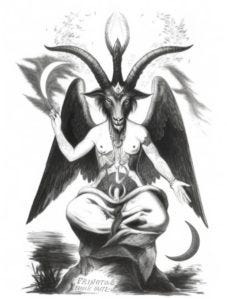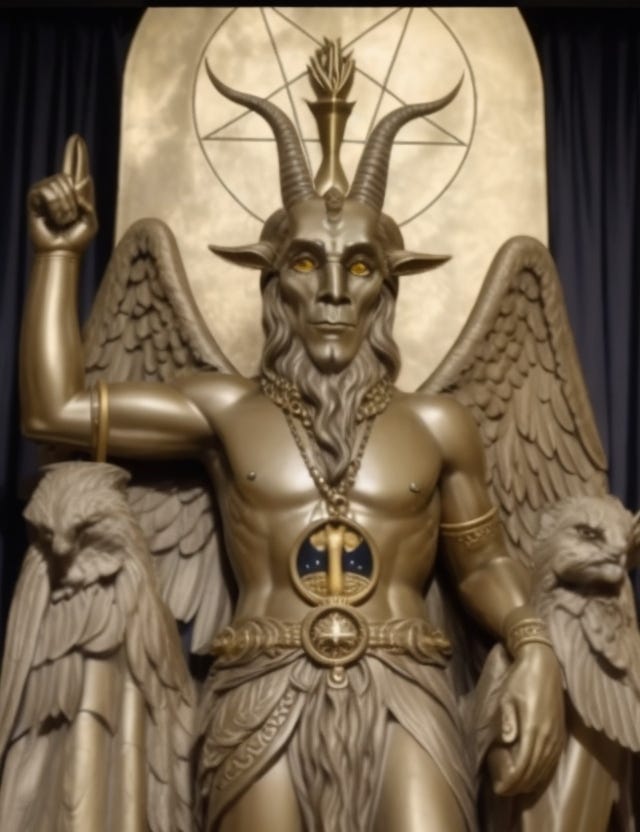The True History and Metaphysical Symbolism of Baphomet
Baphomet is an enigmatic figure associated with the Knights Templar and occultism. But what is the truth behind this legendary emblem and its deeper spiritual meaning? Dive into the origins and symbolism of Baphomet.
The Complete History and Spiritual Symbolism of the Baphomet Emblem
For centuries, the mysterious figure of Baphomet has intrigued occultists and sparked controversy. But what do we really know about the origins and deeper symbolism of this enigmatic emblem?
In this article, we’ll dive into the true history behind Baphomet and uncover its multifaceted metaphysical meanings.
Baphomet
Baphomet is a symbol associated with occult and mystical traditions, representing balance. Its origin is often linked to the Knights Templar and Gnostics, with some considering it a deity or demon.
The French occultist Eliphas Levi created the modern Baphomet. The Knights Templar were accused of worshipping Baphomet during the Inquisition.
The symbol is depicted as a winged creature with a goat head. In recent incidents, a Satanic Temple’s Baphomet idol was destroyed, leading to hate crime charges.
Baphomet’s influence extends to subcultures, fashion, and music, as seen in the metal band Belphegor’s track “Baphomet.”
The symbol remains a mysterious and contradictory figure, influencing various aspects of contemporary culture.
Origins of Baphomet
The first known reference to Baphomet appeared during the inquisitions of the Knights Templar in the 14th century. Accused of heresy, the Knights were said to have engaged in occult practices and taken vows to worship a figure known as Baphomet.
While later interpreted as a devil or demon, it’s unlikely the original Baphomet was ever meant to represent evil. Scholars now believe Baphomet was a symbolic figure used to illustrate occult teachings.
Some believe the name Baphomet originated from a corruption of two Greek words, “baphe” and “metis,” which together mean “absorption of knowledge.”
Others trace it back to the name “Muhammad,” implying the Crusaders may have encountered this figure during their travels to the Middle East.
The Symbolism of Baphomet
Beyond its disputed origins, Baphomet’s enduring symbolism and spiritual significance are truly profound.
As an androgynous human-headed goat, Baphomet represents the balance and harmony of opposite forces in nature—male and female, good and evil, spiritual and physical.
The torch between its horns signifies the light of gnosis, or higher knowledge, that illuminates the path of initiation. Some say this torch represents the kundalini energy that rises up the spine during spiritual awakening.
The white and black teardrops around Baphomet’s face further symbolize the balance of opposites.
Baphomet’s breasts represent the primordial nourishment and sustenance of life. They also serve to balance the rigid masculine energy of the horned goat head.
Some scholars link these breasts to the hermaphroditic nature of primordial creator deities like Osiris.
The caduceus-like rising serpents on Baphomet’s body clearly reference esoteric wisdom traditions involving kundalini awakening. They represent the transmutation and sublimation of base creative forces upwards to the level of spiritual knowledge and liberation.
This theme of polarity, balance, unity, and spiritually transmuted libidinal energies is a constant subtext to Baphomet’s deeper symbolism.
The symbolism of Baphomet, as an emblem of the Gnostic Christian mystics known as the Knights Templar, it suggests an esoteric understanding of the sacred feminine and a more equitable perception of divine polarity, countering the distorted view propagated by the authoritarian church.
No doubt this was threatening to the patriarchal ecclesiastical power structure and helped fuel later Inquisitorial accusations of heresy and devil worship against the order.
Satan, or more accurately, the Kemetic Deity Set, represents a key mystical-alchemical principle in esoteric traditions.
On the deepest level, Satan/Set symbolizes none other than the kundalini energy, or “Christ oil,” that resides dormant at the base of the spine.
In Hindu mysticism, this kundalini power is depicted as a coiled serpent sleeping at the Muladhara chakra.
Alchemical traditions also described it as the primordial fiery dragon force, or magnum opus, coiled around the base of the microcosmic tree of life within each initiate.
When awakened, usually through ritual occult practice or spontaneous spiritual emergency, the kundalini/Christ oil rises swiftly up the sacred sufi column of the Sushumna Nadi.
It stimulates each major chakra in turn, conferring new siddhis (powers) and Gnosis at each step of the inner journey.
Ultimately, the kundalini reaches its zenith expression when uniting the initiate with the transcendental, all-pervading presence of the void at the Sahasrara.
This dissolution into the “Saturnine” black light of non-dual realization was called the nigredo or blackening stage by alchemists, representing the true dark night of the soul.
In alchemy, nigredo, or blackness, means putrefaction or decomposition. Many alchemists believed that as a first step in the pathway to the philosopher’s stone, all alchemical ingredients had to be cleansed and cooked extensively to a uniform black matter. In analytical psychology, the term … Wikipedia
So in essence, Satan and Set are profound mystical allegories and archetypes representing this ouroboric serpent power or Christ oil coiled at the base of existence.
Through its mystical awakening and ascension come the greatest spiritual blessings of gnosis, siddhi, liberation, and unity with the divine black light or void.
Conclusion
Beyond its heretical and controversial history, Baphomet endures as a profoundly spiritual and symbolic emblem of balance, polarity, initiation, and the gnosis of unity.
Though once demonized, Baphomet in fact represents archetypal principles of androgyny and the middle path between rigid dualities.
For occultists and esotericists down through the ages, it has remained a potent sigil of higher gnosis and the light that illuminates the mysteries of nature, divinity, and our own inner spiritual depths.
Through its multifaceted symbolism and long association with esoteric spirituality, initiation, and the ancient quest for balance and wisdom,
Baphomet has endured as one of the most profound and enigmatic figures in the Western esoteric tradition. Its deeper meanings continue to intrigue seekers of higher gnosis even today.
FAQs
Q: What is the true origin of the name Baphomet?
A: The origin is unclear, but theories include a corruption of words relating to wisdom or a reference to the prophet Muhammad.
Q: What do the torches between Baphomet’s horns symbolize?
A: The torches symbolize the higher light of gnosis or esoteric knowledge that illuminates the initiate’s path.
Q: Why was Baphomet significant to the Knights Templar?
A: As gnostic Christian mystics, the Templars’ emblem of Baphomet hinted at their deeper esoteric knowledge and initiation, threatening the patriarchal church.
Here are some excellent resources for further exploring the topic of Baphomet and esoteric symbolism:
“Transcendental Magic” by Eliphas Levi: Levi’s classic 19th-century work includes an in-depth chapter on Baphomet as the symbol of the spiritual summum bonum. It is considered the foremost antique occult text on this subject.
“Sacred Mysteries Among the Mayas and the Quiches” by Augustus Le Plongeon: This fascinating work explores potential connections between pre-Columbian American pyramid symbolism and the Baphomet figure. Illuminates its ancient theological aspects.
“The Gnostic Philosophy” by Stephan Hoeller: Provides an extensive exploration of the history of Gnosticism and its influence on the Western esoteric tradition. Hoeller delves into the Gnostic understanding of self-realization and its embodiment in the esoteric practices of groups like the Rosicrucians [1]. Hoeller’s work contributes to understanding the psychological aspects of tyranny and explores the contrast between Puritanical and Gnostic perspectives [2]. For a brief summary of Gnosticism, readers can refer to Hoeller’s insights on the Gnostic worldview [3]. Additionally, a special interview with Stephan Hoeller provides insights into his life and perspectives on modern Gnostic philosophy [4].
“The Secret Teachings of All Ages” by Manly P. Hall: This comprehensive volume explores Baphomet as a principle of archetypal androgyny and the interplay of chthonic-uranian currents.
“The Knights Templar and their Myth” by Michael Haag: For a survey of theories on Baphomet’s role as an esoteric emblem of the Templars before the order’s suppression.
“Baphomet: The Temple Mystery Unveiled” by Léo Taxil: A lengthy late 19th-century esoteric analysis of Baphomet’s symbolism from a pseudo-Masonic perspective.
Baphomet
Baphomet History, Significance & Symbol
Baphomet | History & Facts
I hope these resources provide a nice starting point for delving more deeply into this profound esoteric icon and its place in the Western mystery tradition.




